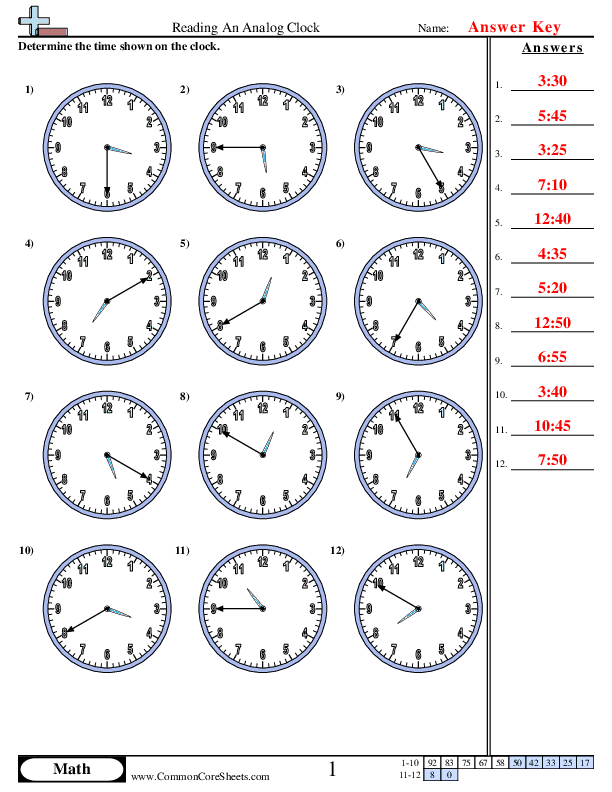Are you looking for the best time worksheets on the internet? Look no further! Our free time worksheets are perfect for teaching students to read a clock, calculate elapsed time, solve start and ending times, and tackle word problems. Our interactive worksheets make it easy for students to learn important concepts related to telling time and understanding intervals between two points in time. With our engaging activities, your students can quickly and accurately practice all of the skills related to telling time. No more wasting "time" looking for worksheets, get your students learning with our top-notch time worksheets today!
Browse Sheets By Problem Type
×
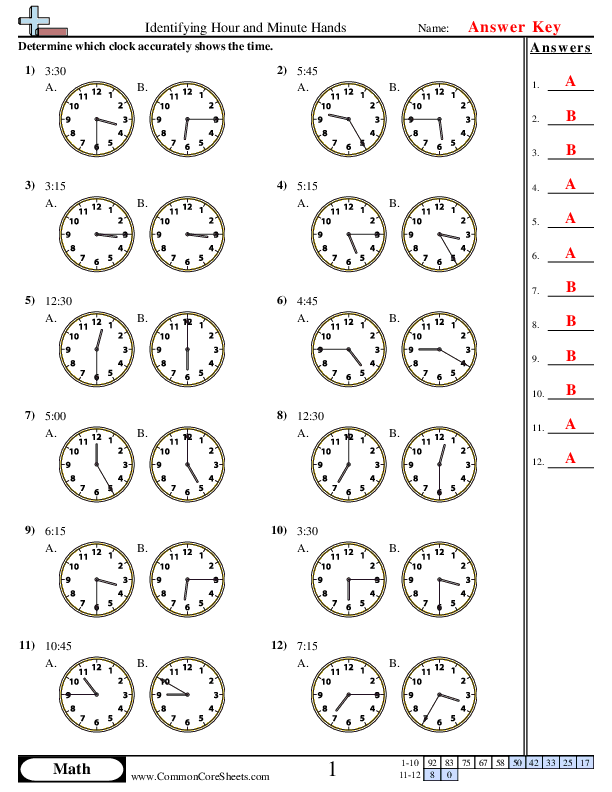
Identifying Hour and Minute Hands


×
Description:
"This worksheet is designed to enhance children's math skills by identifying hour and minute hands. It features 12 engaging problems involving various time-readings, conducive to grasping fundamental time concepts. This worksheet can be easily customized for individual learning pace and goals, transformed into flashcards for efficient memorization or utilized in distance learning platforms. An ideal tool to make learning about time interactive and fun."

×
Student Goals:
Time UnderstandingAfter completing the worksheet, the students will have a solid understanding of how an analog clock works. They will be able to tell the difference between the hour and minute hands and how to correspond them to the right numerals on the clock face. This will aid them in their daily life, allowing them to accurately keep track of time.Math CompetencyThis worksheet focuses on enhancing mathematical abilities in terms of time. By the end of it, learners will be proficient in understanding various intervals of time - full hours, half hours, quarter hours, etc. Moreover, this basic understanding will prove critical when progressing to more advanced math lessons involving calculations with time.Problem-Solving SkillsThrough the worksheet, students will enhance their problem-solving abilities. Presented with different scenarios, they will discern the exact time being displayed on an analog clock. As such, it improves overall cognitive skills by fostering decision-making capabilities and enhancing attention to detail.Application of KnowledgeBy conducting this exercise, the students will be well-equipped to apply their learned knowledge practically. As they become proficient in time understanding, they can effortlessly read time off analog clocks around them – in school, at home, or in public places. This practical applicability makes their learning robust and relevant.Preparation for Advanced LearningThe lessons in this worksheet will act as a stepping stone towards more advanced learning. The fundamental understanding of time will further ease their learning process when they start dealing with more complex mathematical problems linked with elapsed time, time zones, etc.Building ConfidenceFinally, mastering the understanding of time builds a sense of confidence in children. They feel more assured of their learning and become more enthusiastic about learning other concepts. This newfound confidence is beneficial for their overall academic journey – stimulating curiosity, enhancing focus, and encouraging a proactive learning attitude.


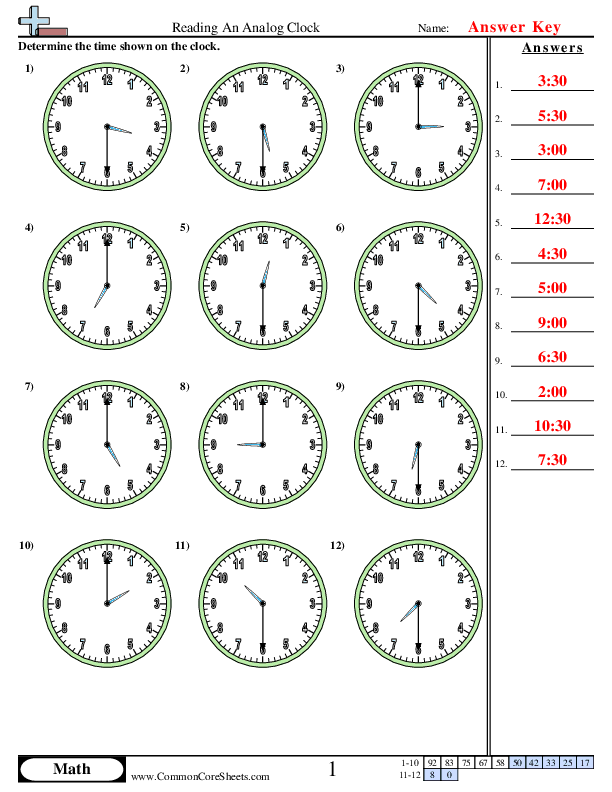
Reading a Clock (Half Hour Increments)
1md3


×
Description:
"This worksheet is designed to enhance children's understanding of reading an analog clock. With a total of 12 math-related problems, the exercises involve conceptualization of the traditional time-telling system. This flexible resource is customizable to meet various learning needs, and can be converted into flashcards for an engaging learning experience. It's also suitable for distance learning, facilitating seamless accessibility and intuitive learning for students wherever they are."

×
Student Goals:
Understanding Time ConceptsAfter successfully completing this worksheet, students should have a solid understanding of analog clock reading. They should be familiar with the positions of the hour and minute hand on a clock face and be able to correlate these positions to specific times. They will also get to understand the concept of elapsing time by interpreting the movement of the clock hands.Practical ApplicationBeyond theory, students will be able to apply what they have learned in this mathematical exercise to real-life situations. The ability to tell time underpins many aspects of daily life, from being punctual for appointments to knowing when to perform daily tasks. Consequently, they will be able to manage their time properly and effectively, strengthening their overall time management skills.Problem SolvingBy practicing these analog clock problems, students will sharpen their problem-solving skills. They will learn to interpret the information provided on the clock and translate that into understandable time formats. By addressing different problems, they will also improve their analytical thinking abilities, learning how to approach and solve varying problems in time-related exercises.Boosting ConfidenceSolving analog clock reading problems can sometimes be challenging, but once students are able to easily solve these problems, it will foster confidence in their mathematical abilities. Any hesitation or nervousness about reading analog clocks would have been addressed and overcome, making them more comfortable with time-telling tasks.Numeracy SkillsThe worksheet will contribute greatly to enhancing students' overall numeracy skills. It will help them improve their number recognition as well as their mental arithmetic, since time-telling often involves a good grasp of numbers and calculations. Additionally, it will build their foundational knowledge for more complex math topics and operations.Fostering IndependenceLastly, this worksheet will foster a sense of independence and self-reliance in the students. As they become adept at telling time, they'll need to rely less on digital devices and others to organize their day or know the time. This is a vital skill that will help them in becoming more self-sufficient and capable, enhancing not only their academic competency but their life skills as well.


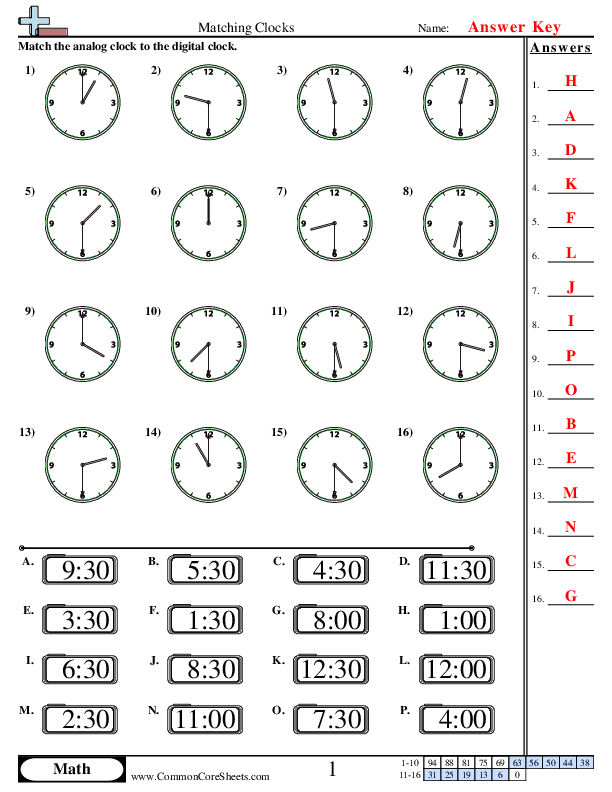
Matching Clocks (Half Hour Increments)
1md3


×
Description:
"This worksheet is designed to reinforce children's understanding of time. Titled 'Matching Clocks,' it offers 16 math problems that challenge students to pair time expressions with corresponding analog clock faces. With its adaptable format, it can be customized to fit varying curricula, converted into interactive flashcards for hands-on learning or implemented in distance education programs to support academic continuity during remote learning situations."

×
Student Goals:
Enhanced Time UnderstandingPost completion of 'Matching Clocks', students will exhibit an improved understanding of how time works. Reading analog clocks will become second nature to them. Converting the analog time to digital becomes easier and errors are minimized. They understand all 12 hours of the clock and how to distinguish 'AM' from 'PM'.Improved Arithmetic SkillsAs this worksheet involves a lot of counting, addition and subtraction, students will have a greater handle on their basic arithmetic abilities. The repetitive practice will instill in them the know-how of quickly calculating time differences.Enhanced Analytical ThinkingThe matching process requires a good deal of logic and rational thought. Students will need to engage their analytical thinking capabilities to correctly pair the clocks with their corresponding times. This repeated exercise over 16 problems augments their analytical capabilities.Develop Time Management SkillsIn real-time situations, the ability to read a clock is directly linked with one's time management skills. By being able to calculate the time and time differences, students can learn to manage their schedule and activities better.Strengthened Problem-Solving AbilitiesThe worksheet equips students with better problem-solving abilities. They need to figure out the correct match for each clock from multiple options, which helps in enhancing their decision-making and problem-solving skills.Increased Accuracy and SpeedThrough repetitive practice of this worksheet, students will get more precise and faster in matching times. The speed and accuracy gained will prove beneficial for them not only in solving academic math problems but also in processing time in day-to-day life.Boosted ConfidenceUpon successfully completing the worksheet, students should feel a sense of achievement. This success can provide a vital confidence boost, stimulating them to take on more challenging math problems and tasks.Greater Academic PerformanceMastering over time reading improves the students' overall math ability. This improved ability reflects positively not only in their math grades but also contributes broadly in other subjects requiring time management or time-estimation tasks.


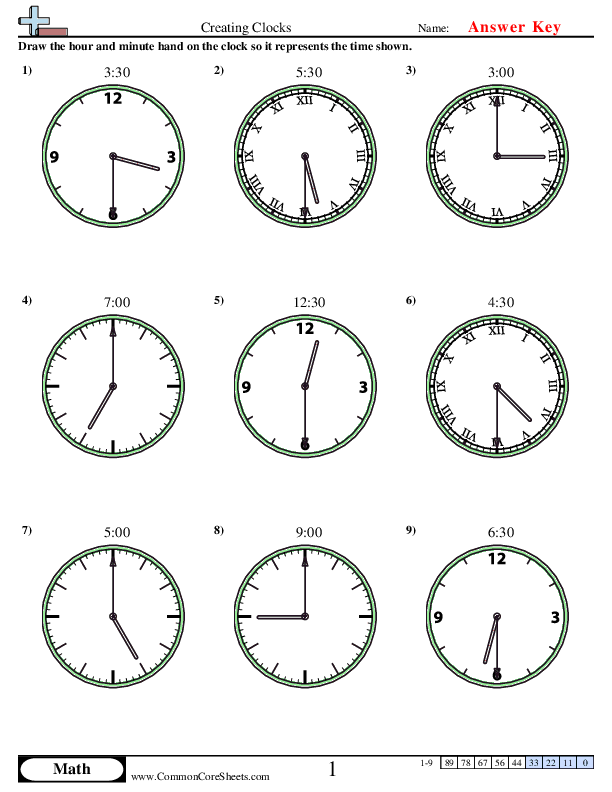
Creating Clocks (Half Hour Increments)
1md3


×
Description:
"This worksheet is designed to help children master the concept of time through the engaging activity of creating clocks. It includes 9 math problems that each present a different time of day. The worksheet offers flexibility for all learning styles and environments—it can be customized to meet individual student needs, converted into flash cards for hands-on learning, or used in distance learning scenarios. An excellent resource for developing essential math skills in a fun, intuitive way."

×
Student Goals:
Understanding Clock FacesAfter completing the worksheet, students should acquire a clear understanding of how traditional clock faces work. Familiarity with the relationship between the short and long arms of the clock and how they denote hours and minutes will allow for error-free interpretation of the time. Through visual recognition of the difference between half-past and o’clock times, they can better understand the concept of time passage.Building Time Telling SkillsAdeptness in telling time on both analog and digital clocks is an essential milestone in children's mathematical learning. By completing the problems provided, they should develop a proficiency in translating time from paper to an actual clock. With improved skill levels, students should not only tell time accurately but also be able to make reasonable estimates about the duration of various events and activities.Enhancing Problem-Solving CapabilitiesUnderstanding the placement and movement of the clock hands enhances children's problem-solving ability. When given a specific time, they should be able to determine the position of each hand on the clock independently. These exercises train children's minds to think logically and solve problems, skills that generalize beyond this specific task.Developing Time Management AwarenessBeing able to tell time accurately is the first step to developing beneficial skills such as time management. As students understand time's passage, they also become aware of life's rhythms and the need for planning and scheduling. Upon completion, students should demonstrate an emerging appreciation for timely task completion.Boosting Math ConfidenceSuccessfully solving time-related problems boost students' confidence in their mathematical abilities. Each correct answer they arrive at, fosters a can-do attitude towards math and instills belief in their quantitative skills. This practice work should help them transition from guided support to independent problem solving in various mathematical contexts, hence encouraging continuous mathematical exploration.


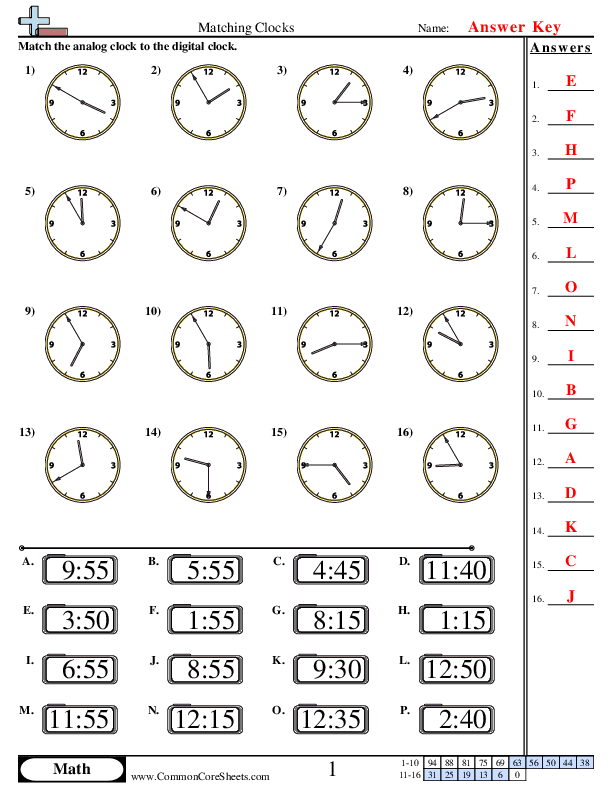
Matching Clocks (5 Minute Increments)
2md7


×
Description:
"This worksheet is designed to enhance children's math skills through 16 engaging 'Matching Clocks' problems. It promotes concepts of time-telling and clock reading in an interactive manner. The worksheet is adaptable to custom needs and can be converted into flashcards for simplified teaching. Perfect for distance learning, it creates an absorbing educational environment for children."

×
Student Goals:
Develop Time-Telling SkillsAfter completing the 'Matching Clocks' worksheet, students should have further developed their ability to accurately read clocks, both digital and analog. They would have practiced recognizing different times and matching them correctly. The understanding of the concept of time, hours, minutes and seconds will be stronger.Improve Problem Solving and Critical ThinkingThe completion of this worksheet would effectively improve the students' problem-solving and critical-thinking abilities. This is achieved as they have to figure out the correct time and match them accordingly. Their analytical skills will be sharpened, and they should be able to use these skills in other aspects of their learning.Boost Confidence in MathematicsAccomplishing this worksheet can also help instill confidence in students' math skills. By successfully solving the problems, they get reassurance in their ability to undertake mathematical tasks and challenges. This confidence can significantly improve their overall performance in the broader subject of mathematics.Gain Practical Real-World SkillTime-telling is a practical real-world skill. Finishing this worksheet means the students have taken one more step in understanding the daily contexts where time interpretation is required - like reading a bus schedule or planning their day. This practice thus brings abstract mathematical concepts into tangible daily life usage.Enhance Accuracy and SpeedWith the repetitious nature of the problems in the worksheet, students will get plenty of practice to improve their speed and accuracy in telling the time. It thus prepares them to perform time-related tasks promptly and efficiently in timed settings.Assimilate Persistent Learning HabitsFinally, the task of completing this worksheet will help students cultivate a habit of persistence. They would learn the importance of regular practice in mastering a particular skill, in this case, time telling, which would be a valuable takeaway for mastering other subjects and skills.


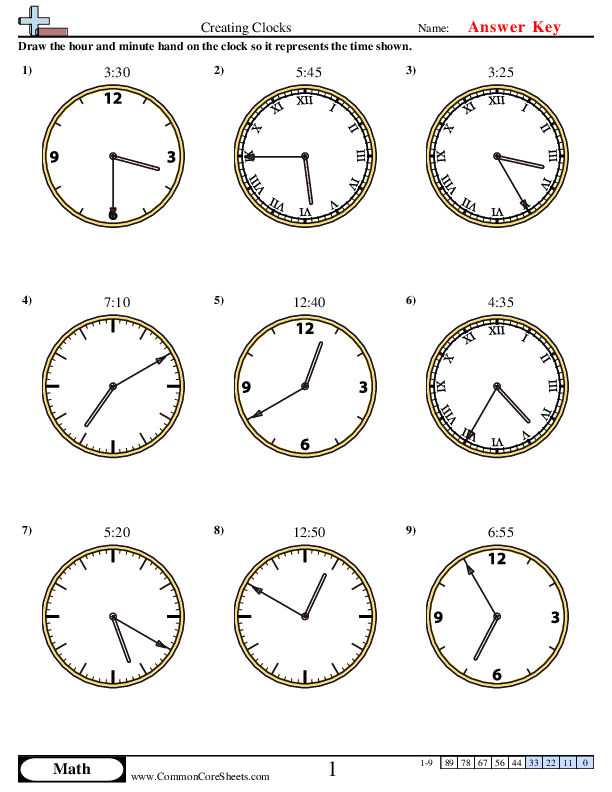
Creating Clocks (5 Minute Increments)
2md7


×
Description:
"This worksheet is designed to enhance children's understanding of time through an engaging 'Creating Clocks' activity. It includes 9 math problems aimed at helping students decipher different time formats. Conveniently adaptable, this worksheet can be customized according to the child's learning pace, converted into flashcards for interactive learning, or utilized in distance-learning settings."

×
Student Goals:
Understanding of the Concept of TimeStudents should develop a thorough understanding of the concept of time after completing the worksheet. They should be able to read, understand, and distinguish the different times given such as hours, minutes, and seconds. They will have an improved ability to tell time, understand the concept of a day, and how it is divided into hours and minutes.Enhancement of Math SkillsBy working on this worksheet, students will enhance their math skills, particularly in the area of telling time. They will learn and practice how to convert time from one format to another. They will also be able to understand the relationship between hours, minutes, and seconds and use this knowledge to solve problems.Improvement in Analytical SkillsThe worksheet is designed to improve students' analytical skills. They will have to analyze the problems given and apply their learned knowledge to solve them. It will enhance their logical reasoning and problem-solving capabilities which are fundamental skills for grasping more complex mathematical concepts in the future.Time Management SkillsThis worksheet aims at instilling the concept of time management in the minds of students from an early stage. They should begin to understand the value of time and how it is essential in planning daily activities. Awareness of time can contribute to better planning and organization of their tasks in the future.Strengthening Concentration and Attention to DetailContinual practice of such time-related problems will lead to an increase in concentration levels and attention to detail in students. They will improve their capability to focus on tasks at hand and pay close attention to minute details key to solving problems correctly.Building ConfidenceSuccessfully solving problems in the worksheet will build students' confidence in their mathematical skills and their ability to understand and work with time. This confidence can translate into other areas of their academics and life, creating a positive effect on their overall learning journey.


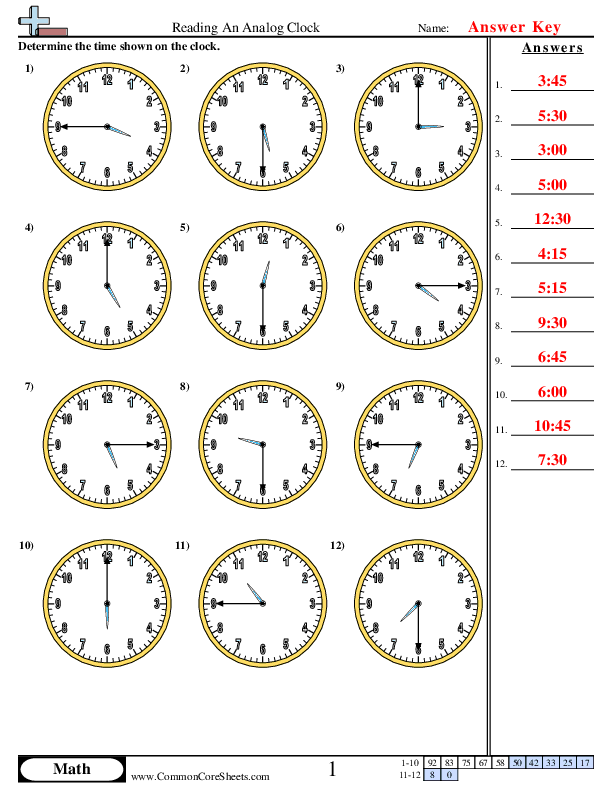
Reading An Analog Clock (15 minute increments)
2md7


×
Description:
"This worksheet is designed to enhance children's mathematical abilities by teaching them to read an analog clock. It features 12 meticulously crafted problems, aimed at reinforcing time-telling skills in a lively and engaging manner. Perfect for distance learning, the material can be effortlessly customized to suit individual needs, and can even be transformed into interactive flash cards for more hands-on learning experiences."

×
Student Goals:
Understanding Time ConceptsAfter completing this worksheet, students should have a foundational understanding of how to read an analog clock. They would have developed skills in identifying the positions of the hour and minute hands and interpreting what each hand's position on the clock face signifies. This helps young learners to gain a basic understanding of the concept of time, an important life skill.Enhancements in Problem-Solving AbilitiesThis worksheet should also encourage improvement in problem-solving skills. Each question serves as a mini problem that requires students to apply their knowledge in a practical way. With continuous practice, they can enhance their logical reasoning and critical thinking abilities which helps them in the longer run in various areas of life.Integration of Knowledge Into Real LifeUpon completion of this worksheet, learners should also be able to translate the knowledge they've gained into real-world situations. They can use these learned skills to tell the time on analog clocks they encounter in everyday life or during math or science concepts that involves measurements or tracking of time.Increased Confidence in MathLearning to read an analog clock and solving related problems can increase students' confidence in their math skills. As they successfully navigate through each problem, they can gain assurance that they are capable of understanding and solving math concepts. This increased confidence can also bolster their enthusiasm for the subject and promote a greater willingness to tackle more challenging math problems in the future.Augmentation of Attention to DetailFinally, this worksheet can help students acquire an attention to detail. Reading an analog clock requires focus on minute features, such as the position of the clock hands. This sharpens their observational skills, promoting an overall enhancement of their attention to detail, a crucial cognitive skill that aids them in various academic disciplines.


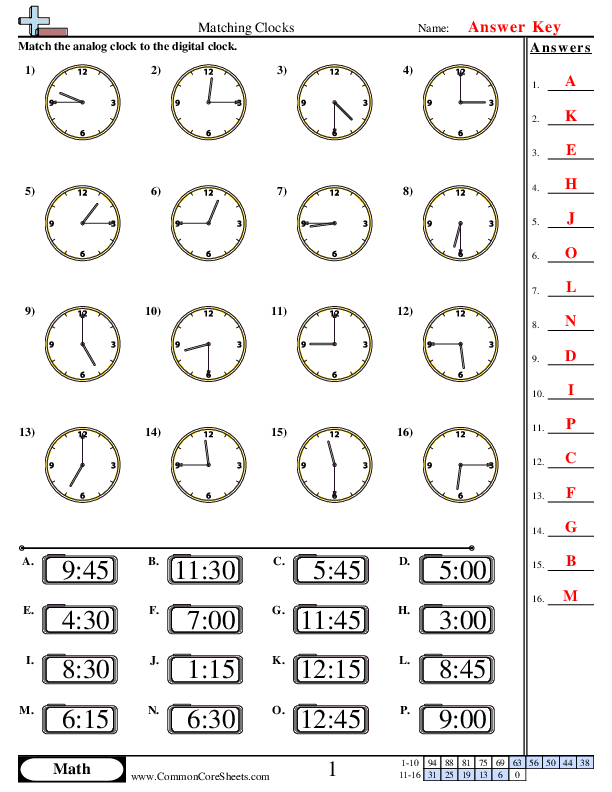
Matching Clocks (15 minute increments)
2md7


×
Description:
"This worksheet is designed to help children grasp the concept of time. Titled 'Matching Clocks', it provides 16 unique math problems that enhance clock-reading skills. Versatile and adaptable, it can be customized to suit individual learner's needs or even be converted into flashcards. Ideal for distance learning, this worksheet is a practical asset for mastering basic math skills in an engaging and interactive way."

×
Student Goals:
Time ReadingUpon completing the 'Matching Clocks' worksheet, students would have honed their skills in reading the time correctly. Whether it's an analogue or a digital clock, they will learn to interpret time accurately, a life skill that stays relevant throughout their lives.Enhanced Math SkillsWorking with time involves complex thinking and calculation skills. Students will learn to apply mathematical operations to determine the difference between times and understand the concept of elapsed time. This exercise will not only enhance their mathematical abilities but also cultivate analytical thinking skills.Time ManagementUnderstanding time is the first step towards mastering the art of time management. This worksheet involves exercises that make students cognizant of how time flows, enabling them to develop a basic understanding of planning and scheduling. This, in turn, can help them manage their daily tasks efficiently, contributing to better productivity in the long run.Logical ThinkingCompletion of the 'Matching Clocks' worksheet would encourage the development of logical thinking abilities among students. They will learn how to resolve problems that involve time in a step-by-step manner, which can also aid in enhancing their problem-solving abilities.Improved Accuracy and SpeedThe regular practice provided by this worksheet will ultimately lead to increased accuracy and speed when telling time. As students continue to match the clocks with the correct times, the speed of recognising time, along with precision, will progressively improve.Real-world ConnectionsWorking with real-world applications like time can enhance a student's interest in math, leading to a deeper understanding of how the subject is woven into everyday life. After the completion of this worksheet, students will start recognising the importance of time in various scenarios such as preparing a schedule, catching a bus, or timing a game.



Creating Clocks (15 Minute Increments)
2md7


×
Description:
"This worksheet is designed to teach kids critical math skills, specifically, telling time. The 'Creating Clocks' worksheet offers nine problems for children to illustrate different times visually. It can be customized as per child's learning pace or converted into flashcards for hands-on activities. Furthermore, it's suitable for distance learning, allowing students to interactively learn a fundamental math concept from the safety of their homes."

×
Student Goals:
Understanding TimeUpon completion of the worksheet, students should have gained a solid understanding of time. They will be able to read different times presented, enhancing their familiarity with the concept of the hour and minute hands. By recognizing and differentiating between hours and minutes, they develop a basic yet crucial element of time management and daily scheduling.Interpreting ClocksThis worksheet will enable students to interpret a number of times from clock diagrams. They will learn to translate a position of hour and minute hand into an actual time. These key time-telling skills will be applicable not just in academic and homework scenarios, but also in real-life situations, making them more autonomous and aware.Problem-solvingSolving different problems within the worksheet will enhance the students' problem-solving abilities. Each problem requires the child to shape an understanding of the time which is an abstract concept. By practicing these problems, children will develop their analytical skills, critical thinking abilities, and attention to detail.Boosting ConfidenceSuccessfully completing the worksheet can give students a confidence boost in regard to their mathematical abilities. Time-telling is an essential academic and life skill. Mastering such a skill at a young age can make students feel accomplished and set the tone for successful learning in more complicated fields.Application in Daily lifeFinally, after completing the worksheet, students can apply their knowledge to their daily routines. Understanding time will allow them to keep track of time spent on tasks, to understand and follow their schedules and timetable, arriving on time for school and other activities. The increased independence and responsibility will translate into better time management and punctuality.


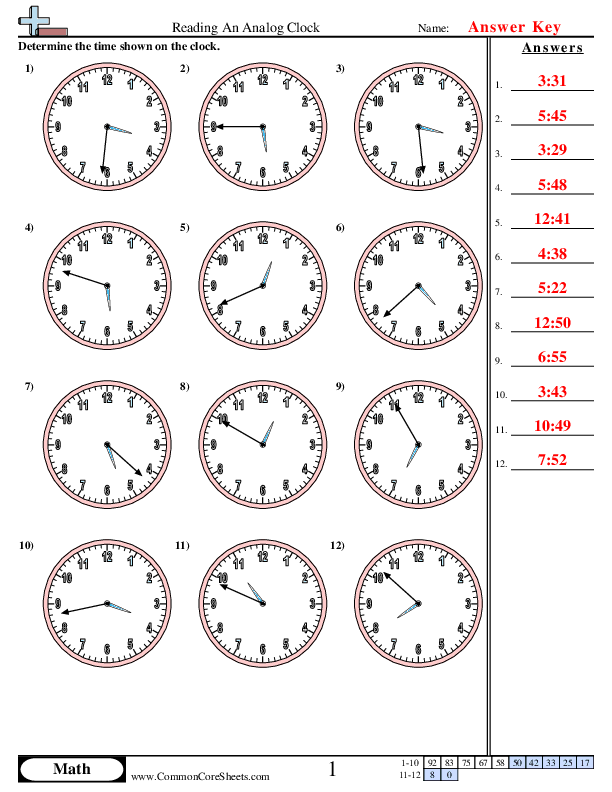
Reading a Clock (1 Minute Increments)


×
Description:
"This worksheet is designed to enhance children's understanding of reading analog clocks, an essential part of their math curriculum. With 12 varied problems, it fosters the practical application of time-telling skills. Its flexible format allows customization, conversion into flashcards for nimble learning, or use in distance learning environments. Ideal toolkit to make mastering time enjoyable and effective for young learners."

×
Student Goals:
Reading Time MasteryUpon successful completion of this worksheet, children should have mastered the fundamental skill of reading an analog clock. This includes understanding the placement of the hour and minute hands and how they represent time. Reading an analog clock is a classic essential skill that leads to a more profound temporal comprehension.Analog to Digital ConversionStudents will gain the ability to confidently and competently convert the time shown on an analog clock to a digital format. This conversion skill strengthens their digital literacy and ensure they are able to interpret and communicate time using both traditional and modern forms.Mathematical ProficiencyThis worksheet supports the development of children’s basic mathematical skills, such as addition and multiplication, through the act of calculating minutes and hours. It serves as an effective tool in illustrating the practical application of these mathematical operations in routine daily activities.Real-Time ApplicationsBy learning to read an analog clock, students can apply this knowledge to real-world situations. Whether it's determining the time for their favorite TV show, school bus schedule, or family activities, they can better manage their time and develop planning skills essential for personal and academic growth.Temporal AwarenessCompleting this worksheet will enhance students' temporal knowledge. They will learn about the concept of time, including seconds, minutes, and hours, and its passage. This will positively impact their ability to schedule events, estimate the duration of activities, and improve their overall time management.Problem-Solving SkillsWorking through the problems in this worksheet will foster improved problem-solving skills. As they engage in decoding the positions of clock hands, students will experience the process of resolving practical problems, thereby boosting critical thinking skills beneficial for many subjects and aspects of life.


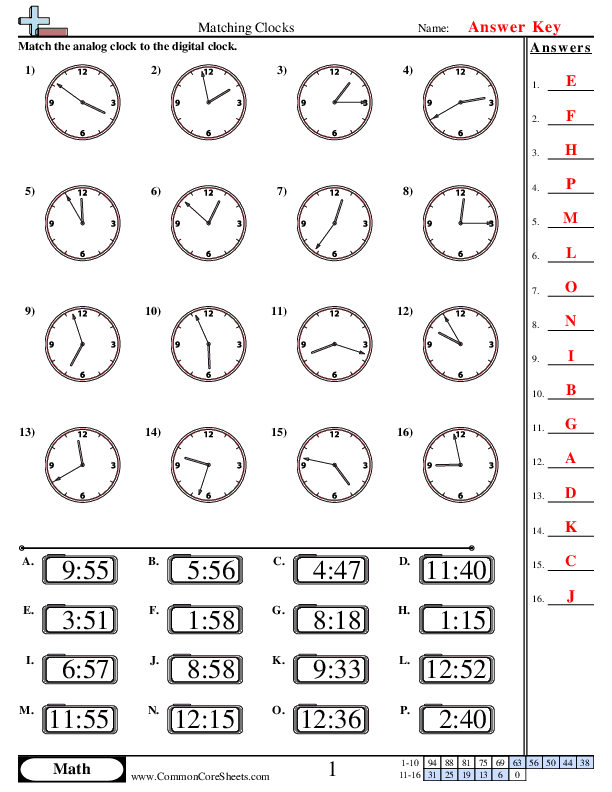
Matching Clocks (1 Minute Increments)


×
Description:
"This worksheet is designed to boost children's math skills through unique 'Matching Clocks' exercises featuring 16 problems. It encourages understanding of time-telling concepts in a fun and interactive way. The worksheet is customizable to cater to individual learning speeds and can be converted into flashcards for ease of use. Ideal for remote or distance learning, it adds versatility to every child's learning journey."

×
Student Goals:
Understanding TimeAfter completing this worksheet, students should have a stronger understanding of how to read time on analog and digital clocks. They should be able to comfortably tell and match the times represented on different types of clocks. This foundational ability is critical as the concept of time is a fundamental aspect of everyday life.Mathematical SkillsThe worksheet will enhance students' basic math skills as they will practice comparing and matching different times, which involves concepts of greater than, less than, or equal to. Furthermore, it helps in understanding the concept of time intervals which is a key component in arithmetic.Problem Solving and Analytical SkillsBy wrestling with different time-matching problems, students will learn to apply logical thinking, observational, and problem-solving skills. They will be confronted with varying problem scenarios which require keen analysis and a systematic approach to arrive at correct responses.Concentration and Attention to DetailThis worksheet will also help in improving the students' concentration levels. Dealing with the intricacies of matching clock times, noticing minute and hour hand positions, and ensuring correct matches requires and therefore fosters attention to detail.Confidence and AchievementLastly, the worksheet is designed to cultivate a sense of achievement and confidence in students. As they successfully solve the problems and match the correct times, they will feel accomplished. This progress can serve to motivate them further in their learning journey and grow their love for the subject of math.


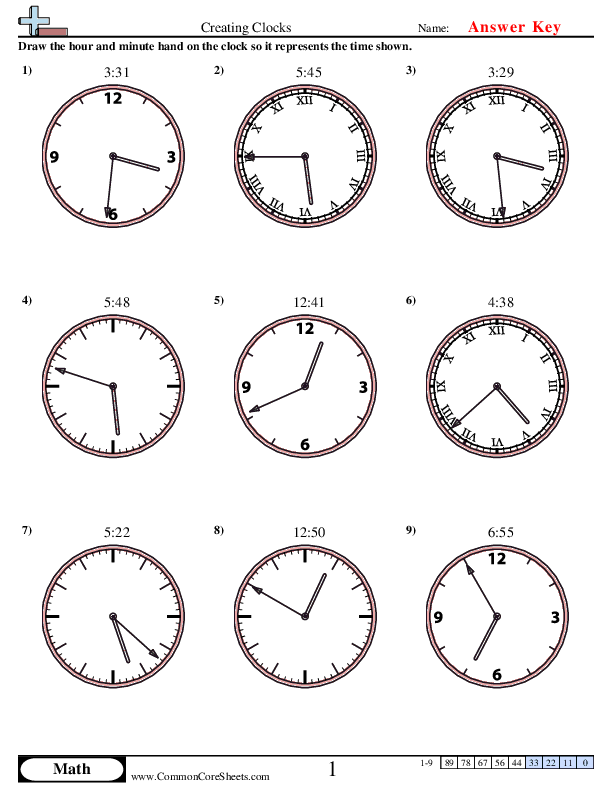
Creating Clocks (1 Minute Increments)


×
Description:
"This worksheet is designed to enhance children's math skills, particularly time recognition, through a fun and interactive 'Creating Clocks' activity. Featuring nine problems with various times, it offers kids a way to effectively practice and understand the concept of time. Importantly, this worksheet can be versatilely customized, converted into flashcards for additional practice, or incorporated into distance learning platforms, making it an adaptable tool for diverse learning environments."

×
Student Goals:
Time UnderstandingStudents should develop a thorough understanding of how time is told and how to interpret it on analog and digital clocks. This skill is not just mathematical but practical, as it is used daily in multiple real-life contexts, such as understanding schedules and planning activities.Mathematical Skill EnhancementBy engaging with time-related problems, students hone their counting and arithmetic skills. Additionally, students learn about concepts like hours, minutes, and seconds, further broadening their competence in number systems and computations.Problem-Solving AbilitiesDealing with time-related problems encourages logical thinking, which can increase a student's problem-solving skills. As they determine the problems' solutions, they employ deductive reasoning and critical analysis, improving their analytical abilities in the process.Confidence and AutonomySuccessfully managing time-related tasks can boost a student's confidence in their mathematical skills. This self-assuredness can lead to an increased desire for independence, as they apply the skills learned to everyday situations, such as reading bus schedules or planning their day.Foundational Knowledge in TimeUnderstanding how to read a clock is a foundational skill that aids in learning more complex time-related concepts such as elapsed time, calculating the duration of events, and understanding timelines. Mastering these basics provide a strong foundation for more advanced mathematical lessons.Cognitive DevelopmentBy thinking critically to solve the problems in the worksheet, students stimulate and advance their cognitive development. This cognitive growth goes beyond academics, extending into daily life and personal growth.Time Management SkillsBy understanding the concept of time, students can gradually grasp the idea of time management. Recognizing the importance of time prepares them for a set of essential life skills such as punctuality, organization, and efficient planning.






